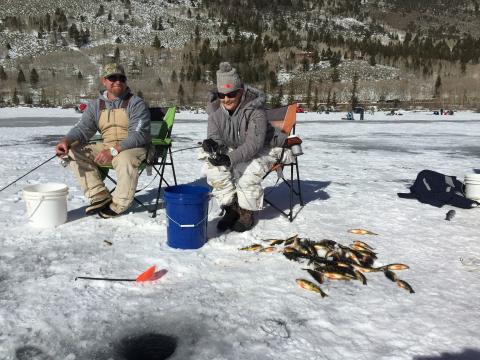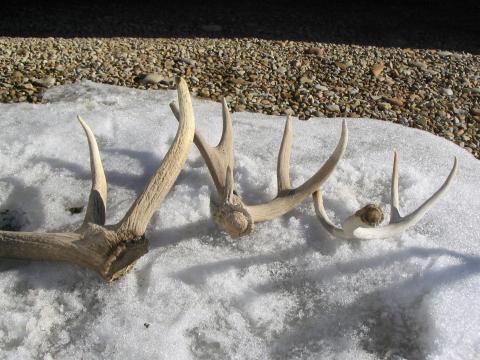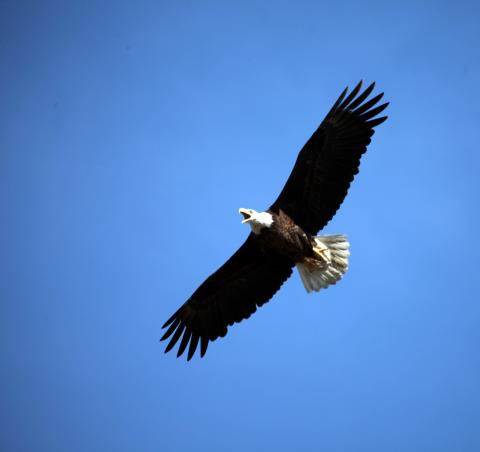



Fish Lake Perch Tournament Canceled
Sevier County – Unsafe ice conditions have forced the Division of Wildlife Resources to cancel one of Utah’s most popular fishing events.
The Fish Lake Perch Tournament, scheduled to begin on Feb. 24, will not be held this year.
“Safety is our top priority,” says Richard Hepworth, Southern Region aquatic manager for the DWR. “Unfortunately, the ice isn’t safe enough to hold a large event at Fish Lake this year. And, based on the long-term weather forecast, we don’t think the ice conditions will improve much between now and Feb. 24.”
You can still win a prize
Even though the tournament has been canceled, you still have a chance to win a prize. DWR biologists have placed tags on 1,000 yellow perch in the lake. If you catch a tagged fish between Feb. 3 and Aug. 31, take it to the Fish Lake Resort Store, or the Bowery Haven Resort, for a chance to win a firearm donated by Sportsmen for Fish and Wildlife. The prize drawing will be held Sept. 1.
“The more tagged fish you catch,” Hepworth says, “the more chances you have to win.”
Ice fishing still possible
Even though the ice at Fish Lake can’t support a large tournament event—almost 2,000 people have attended the event every year it’s been held—there are still spots that are safe for individual anglers and small groups.
“We encourage people to take advantage of these conditions and go fishing,” Hepworth says. “Just be safe, and check ice conditions before venturing too far from shore.”
An infographic that shows the amount of ice needed before venturing onto it is available at www.udwrnewsphotos.zenfolio.com/p220927222.
You can get the latest ice conditions for Fish Lake by calling Fish Lake Resort at 435-638-1000. Weekly updates are available from the DWR at www.wildlife.utah.gov/hotspots/reports_sr.php.
ust Complete Course before Gathering Shed Antlers
Take the course at wildlife.utah.gov/shedantler
Collecting antlers that fall off the heads of deer, elk and moose each winter is a popular pastime in Utah.
Before you head out the door to collect shed antlers, though, you must complete the Division of Wildlife Resources’ Antler Gathering Ethics course. You can take the free course at www.wildlife.utah.gov/shedantler.
After dropping their antlers, male deer, elk and moose will grow a new set starting this spring.
Gathering shed antlers
DWR Captain Justin Shirley says gathering shed antlers is a fun activity that your whole family can enjoy. Please remember, though, that late winter and early spring is a tough time of year for deer, elk and moose.
“During winter,” Shirley says, “big game animals, especially deer, often have a difficult time finding food. If you spook an animal and cause it to run, the animal has to use up fat reserves and energy it needs to make it through the winter.”
Also, from late winter through early spring, the habitat big game animals rely on in the winter is usually wet. “Because the soil is wet,” Shirley says, “it’s more at risk to damage.”
Fortunately, you can gather shed antlers without stressing the animals or damaging their habitat. “The free course will teach you how,” Shirley says.
Print your certificate
After you finish the course at www.wildlife.utah.gov/shedantler, you must print your certificate of completion and then carry it with you while you’re gathering antlers.
If you have young children, and you’ve completed the course, your children don’t need to complete it—your certificate will cover your kids too.
You must complete the course if you want to gather shed antlers between Feb. 1 and April 15. If you wait until April 15 or later to gather antlers, you don’t need to complete the course.
After you’ve completed the course, you can gather antlers across Utah. There are two exceptions, though:
- Many of the state’s wildlife management areas are closed in the winter and spring, to protect animals and their habitat.
- You must have written permission from the landowner before gathering antlers on private land.
Antlers attached to a skull
If you find a skull with the antlers or horns still attached, it's possible the animal was poached. Do not pick up or move the skull, or disturb footprints or other evidence. Instead, please take the following steps:
- Take photos of the skull from a couple of angles
- Pinpoint the location of the skull (preferably its GPS coordinates)
- Report your find to a DWR office
- Provide key details in your report
The DWR will send a conservation officer to investigate. If it's clear the animal died of natural causes, you might be allowed to keep your find.
More information
If you have questions about gathering shed antlers in Utah, call the nearest Division of Wildlife Resources office or the DWR’s Salt Lake City office at 801-538-4700.
ee Bald Eagles
February is Bald Eagle Month in Utah
February is the best time of the year to see one of the country’s most iconic birds.
Bald eagles fly to Utah in the winter to find food and escape colder conditions farther north. By the time February arrives, hundreds of eagles are in the state.
You can see the eagles, and learn more about them, during Bald Eagle Month.
Matt Bartley, special events coordinator for the Division of Wildlife Resources, says the agency has expanded its former Bald Eagle Day to include several Saturdays of viewing.
“Holding viewing events at different times, in different parts of the state, will give folks across Utah the best chance to see the greatest number of eagles,” Bartley says.
In the past, the DWR held the event on a single Saturday in February.
“On the day we held the event,” he says, “some of the sites had good numbers of eagles while other sites had fewer birds. In some cases, eagles hadn’t arrived at the sites in good numbers yet. In other cases, they’d already come and gone. Holding the event on different Saturdays should increase the chance you see eagles on the day you attend.”
Seeing the eagles is free. You can see eagles during the following days and times:
Feb. 3
Southwestern Utah
Rush Lake Ranch, 9600 North on the Minersville highway (SR-130). The ranch is about 12 miles north of Cedar City.
Viewing on Feb. 3 takes place from 8 a.m. to noon.
Feb. 10
Northern Utah
Salt Creek Waterfowl Management Area (Compton’s Knoll), located about 10 miles northwest of Corinne
Viewing on Feb. 10 takes place from 9 a.m. to 2 p.m.
To reach the Salt Creek WMA, exit Interstate 15 at Exit 365, and travel west on state Route 83 through Corinne. Stay on SR-83 until you get to 6800 West (Iowa String). Turn right on 6800 West, and travel north to 6800 North. Once you reach 6800 North, the WMA’s Compton’s Knoll Watchable Wildlife site will be on your left side.
Wasatch Audubon and the DWR are co-sponsoring the event at Salt Creek.
Farmington Bay Waterfowl Management Area, located on the west side of Farmington at 1325 W. Glovers Lane (925 South)
Viewing on Feb. 10 takes place from 9 a.m. to 3 p.m.
The DWR and the Wild About Birds Nature Center in Layton are co-sponsoring the Farmington Bay event.
Central Utah
Fountain Green State Fish Hatchery, located east of Nephi
Viewing on Feb. 10 takes place from 9 a.m. to 3 p.m. Free tours of the Fountain Green State Fish Hatchery will also be offered.
If you’re coming from the north, you can reach the hatchery by taking Interstate 15 and exiting the freeway at the second Nephi exit (Exit 225). After exiting the freeway, turn east on state Route 132 and travel about 10 miles. About one mile before the city of Fountain Green, a Bald Eagle Day sign will point you to an access road that leads to the hatchery.
Once you reach the hatchery, you’ll receive a driving map of the Sanpete Valley that highlights the best areas in the valley to view eagles. Literature, displays and bathroom facilities will also be available at the hatchery. Spotting scopes will be set-up at a nearby location where eagles often gather in a large tree. The viewing site is about one mile from the hatchery.
Feb. 24
Northeastern Utah
Ouray National Wildlife Refuge, near the refuge headquarters in Randlett at 19001 E. Wildlife Refuge Road
Viewing on Feb. 24 takes place from 8 a.m. to noon.
To reach the site, travel on U.S. 40 about 14 miles west of Vernal, or about 13 miles east of Roosevelt, and turn south on state Route 88. Travel south on SR-88 for 14 miles, and then turn left into the refuge entrance. The refuge headquarters is one mile down the entrance road.
The Ouray National Wildlife Refuge and the DWR are co-sponsoring the event.
Get a close look
Bartley says spotting scopes will be available at each viewing site so you can get a good look at the eagles. “If you have any challenges spotting the eagles,” he says, “our biologists and volunteers will help you find them. We’d also be happy to answer any questions you have.”
You can also pick up a Bald Eagle Month button. Handouts and information about bald eagles, wildlife watching and birding opportunities in Utah will also be available.
The button and information are free.
Items to bring
If you attend Bald Eagle Day, dress in warm clothes and bring waterproof boots. Also, if you want to take photos of the eagles, bring a telephoto lens.
“You need a telephoto lens to get good, close-up shots of the eagles,” Bartley says. “The eagles will be fairly close to the viewing sites, but you still need a telephoto lens to get good photos of them.”
More information
If you have questions about Bald Eagle Month, call Division of Wildlife Resources offices in Ogden, Springville, Vernal or Cedar City.
Fishing reports - available at http://wildlife.utah.gov/hotspots .